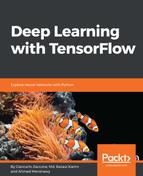Similar to the biological one, the artificial neuron consists of the following:
- One or more incoming connections, with the task of collecting numerical signals from other neurons; each connection is assigned a weight that will be used to consider each signal sent
- One or more output connections that carry the signal for the other neurons
- An activation function determines the numerical value of the output signal, on the basis of the signals received from the input connections with other neurons, and suitably collected from the weights associated with each picked-up signal and the activation threshold of the neuron itself
The following figure represents the artificial neuron:

The output, that is, the signal whereby the neuron transmits its activity outside, is calculated by applying the activation function, also called the transfer function, to the weighted sum of the inputs. These functions have a dynamic between -1 and 1, or between 0 and 1.
There is a set of activation functions that differs in complexity and output:
- Step function: This fixes the threshold value x (for example, x= 10). The function will return 0 or 1 if the mathematical sum of the inputs is at, above, or below the threshold value.
- Linear combination: Instead of managing a threshold value, the weighted sum of the input values is subtracted from a default value; we will have a binary outcome, but it will be expressed by a positive (+b) or negative (-b) output of the subtraction.
- Sigmoid: This produces a sigmoid curve, a curve having an S trend. Often, the sigmoid function refers to a special case of the logistic function.
From the simplest forms, used in the prototyping of the first artificial neurons, we then move on to more complex ones that allow greater characterization of the functioning of the neuron. The following are just a few:
- Hyperbolic tangent function
- Radial basis function
- Conic section function
- Softmax function
It should be recalled that the network, and then the weights in the activation functions, will then be trained. As the selection of the activation function is an important task in the implementation of the network architecture, studies indicate marginal differences in terms of output quality if the training phase is carried out properly.

In the preceding figure, the functions are labeled as follows:
- a: Step function
- b: Linear function
- c: Computed sigmoid function with values between 0 and 1
- d: Sigmoid function with computed values between -1 and 1
